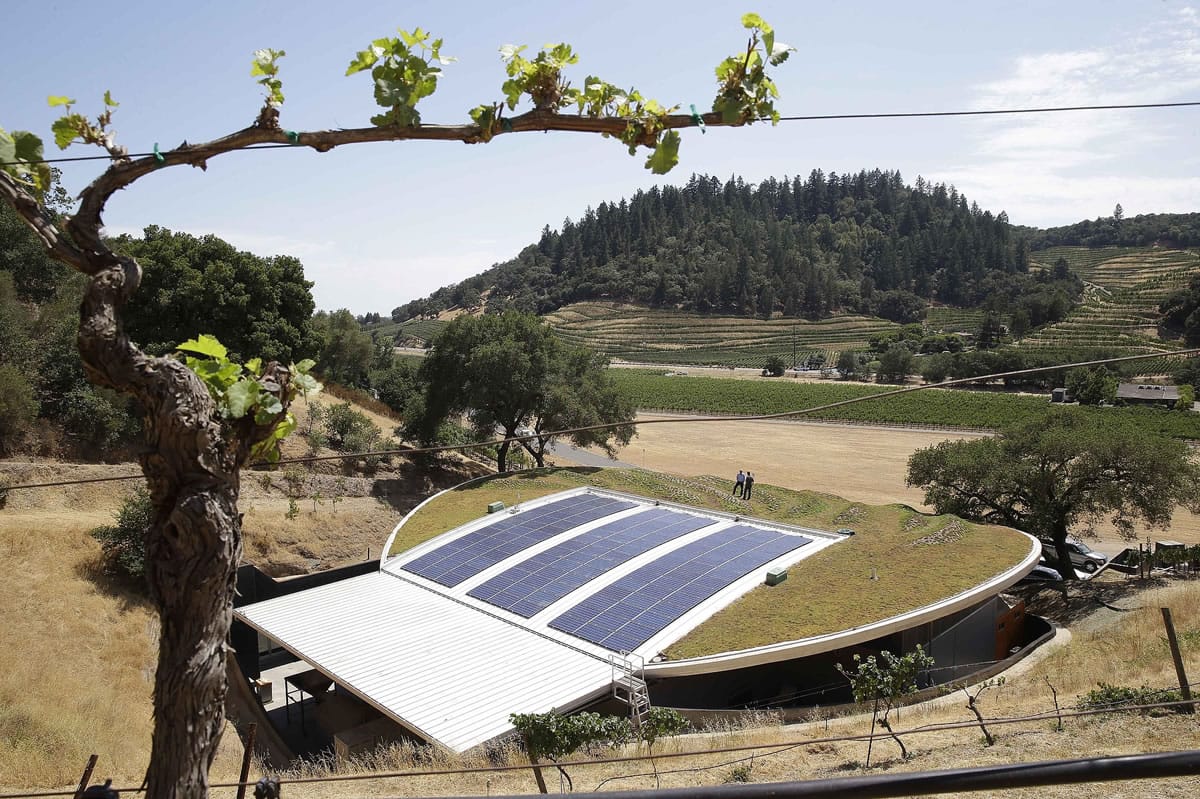NAPA, Calif. — It’s a warm day in the Napa Valley and the summer sun that turns the region’s plump grapes into prized cabernet sauvignon is beating down on the Odette Estate winery.
But inside the winery’s production facility, temperatures are pleasant — with nary a whisper of air conditioning.
The reason is Odette Estate’s innovative roof, which combines 8,500 square feet of planted, living roof with 2,500 square feet of solar panels.
“It’s really cool working underneath something you know is helping the environment and not impacting it in a negative way,” says Christian Oggenfuss, director of marketing for Odette Estate. “I’m pretty proud, actually, that this spot right now is greener than it was when we started.”
Odette Estate, which opened recently, is part of a small but blossoming trend of green-roofed wineries.
In Sonoma County, next door to the Napa Valley, Hamel Family Wines has a living roof on top of its production facility, part of a 124-acre property with panoramic views of the Sonoma Valley. In Oregon wine country, the Sokol Blosser winery has a green-roofed tasting room.
Further afield, there are wineries with green roofs in New Zealand, including Mt. Difficulty winery in New Zealand’s Central Otago growing region, near Queenstown. And Antinori Chianti Classico Cellars in Italy’s Tuscany region has grape vines growing on its roof, which is built into a hillside. The cellars took seven years to create, and were designed with the goals of having a low environmental impact and saving energy.
Green roofs make sense for wineries, but they’re also catching on for other commercial uses, says Stephen Peck, founder and president of the trade association Green Roofs for Healthy Cities, based in Toronto.
The group estimates that in 2013 there were more than 20 million square feet of green roofs installed in North America.
Green roofs have to be designed to suit their climate, but they can go just about anywhere, from the Yukon to the tropics, says Peck.
And while most green roofs top commercial, industrial and institutional buildings or high-end homes, there are some single-family homes with modest versions of green roofs.
In cities made hotter by black asphalt and black roofs, a green roof lets some of the heat out and can also provide a place to relax or grow food.
The type of plants used on roofs depends on how deep the soil is. Low-maintenance plants that can handle hot, dry conditions can thrive in about 6 inches of soil; roofs with 12 inches of soil can support shrubs and vegetables. Odette Estate’s roof grows native plants.
For wineries, green roofs help create the stable temperatures needed to store wine.
At Odette Estate, there’s a large, low-velocity fan to keep things moving but no AC, except in the recycled shipping containers that have been transformed into offices and a lab.
Odette Estate is owned by a partnership including John Conover, Gavin Newsom (who is also California’s lieutenant governor) and billionaire Gordon Getty. The three also are involved in PlumpJack Winery and CADE Winery.
The Odette roof is circular to fit in with the flowing lines of the property, and has an underground irrigation system to stop precious water from evaporating. A meter monitors when the plants need moisture, and in the rainy season, storm water will be collected in gutters and fed into an underground cistern.
The building isn’t open to the public since it’s a working facility, but visitors can see the roof on walking tours of the property.
The one worry you have with a green roof that you don’t with a conventional roof? Weeds.
Luckily, in today’s evolving world there’s a fix for that.
“We have a crew that specializes in green living roofs that goes up there” for regular weeding, says Oggenfuss.



